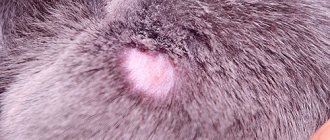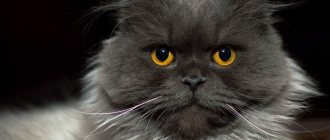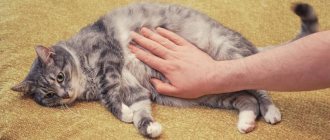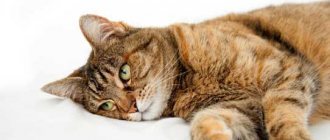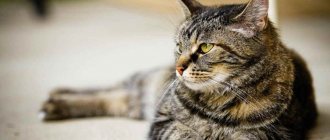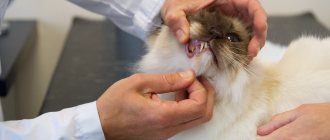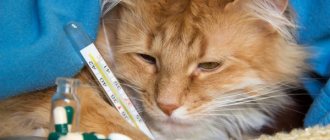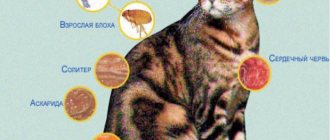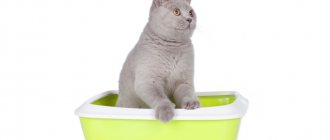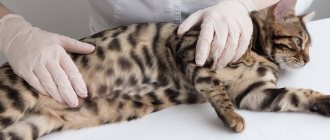Anemia is a clinical and hematological syndrome, which is a decrease in the number of red blood cells and hemoglobin per unit volume of blood. In this case, the volume of blood in the cat’s circulatory system may be within normal limits or even more.
Red blood cells (erythrocytes) are a special type of blood cell that contains hemoglobin - a complex protein that includes iron, which has the ability to bind incoming oxygen. During the process of breathing, oxygen entering the cat’s lungs from the surrounding air is adsorbed in the capillary network of the lungs by blood (erythrocytes), binding to the hemoglobin of erythrocytes. During circulation through the bloodstream, hemoglobin transfers oxygen to the tissues of the body, since without it, not a single biochemical reaction in animals occurs in the body. It is the hemoglobin in red blood cells that colors the blood its characteristic red color.
Red blood cells are produced in the bone marrow and released into the bloodstream, where they live for about two months. As red blood cells age, they are filtered from the circulatory system into the spleen. The iron found in red blood cells is recycled to create new red blood cells.
If a cat is anemic, the ability of its red blood cells to absorb oxygen in the lungs and deliver it to body tissues is reduced and the cat appears lethargic and weak.
Anemia in cats occurs for a number of reasons, which can be divided into four groups:
- The process of disrupting blood formation.
- Blood destruction disorder.
- Violation of the balance between the formation and destruction of blood cells.
- Genetic malfunction in the cat's body.
Depending on the cause that caused the pathological condition in the cat, veterinary specialists distinguish the following types of anemia:
- Nutritional.
- Hemolytic.
- Hypoplastic.
- Aplastic.
- Posthemorrhagic.
Characteristics of the condition and its features
Anemia is characterized not only by a decrease in the number of red blood cells, but also by a drop in the level of hemoglobin, an iron-containing protein involved in gas exchange. Due to lack of oxygen and excess carbon dioxide, all internal organs suffer. This affects immunity, acid-base balance, heart and kidney function.
The disease in mustachioed pets is much more acute than in humans. The thing is that it takes too much time for the body to restore red blood cells. But in case of mass death it is simply not there, so saving the animal without veterinary care is impossible.
Symptoms of anemia
If a cat's hemoglobin level in the blood is reduced, the following signs of iron deficiency develop:
With this pathology, the animal often has pale gums.
- pale gums; with the hemolytic variety, the mucous membranes acquire a pale yellow color;
- lethargy, drowsiness, apathy;
- tachycardia;
- dyspnea;
- loss of appetite;
- weight loss;
- retardation in growth and development;
- stool disorder;
- eating inedible substances - plaster, toilet filler, own excrement.
Types depending on the lack of a certain element
Symptoms and methods of treating anemia in cats depend on its type. The classification is based on the lack of a certain element.
Autoimmune (hemolytic)
Autoimmune, or hemolytic, anemia in cats develops when red blood cells are destroyed. Its main symptom is jaundice, caused by poisoning or disruption of hematopoietic processes.
Infectious
Infectious anemia in cats is caused by low hemoglobin concentrations caused by leukemia, immunodeficiency, salmonellosis, bartonellosis, or streptococcal infection. These diseases lead to malfunctions of the bone marrow.
Nutritional
This type of anemia often occurs in newborn kittens and animals younger than 1.5 years. Iron deficiency, associated with poor feeding or impaired absorption function, is to blame for its development.
Posthemorrhagic
Occurs due to internal and external bleeding, accompanied by loss of red blood cells and hemoglobin. Depending on the number and severity of wounds, it occurs in acute or chronic form. The main cause of this disease is flea infestations and helminthiasis.
Hypoplastic
Develops with a deficiency of vitamin B, iron, copper, cobalt and protein, as well as with toxin poisoning. Accompanied by a disorder of bone marrow functions.
Aplastic, or iron deficiency
Aplastic, or iron deficiency, anemia in cats is characterized not only by low levels of hemoglobin and red blood cells, but also by a reduction in the number of white blood cells. May be accompanied by an inflammatory process in the bone marrow or liver.
Diagnosis of the disease
An important reminder to pet owners: established symptoms of anemia must be confirmed by a comprehensive diagnostic examination. Moreover, the reliability and correctness of diagnosis is achieved only by comprehensive measures:
- a clinical examination allows you to identify characteristic signs, assess the severity of the general condition, compare them with medical history and suggest possible causes, as well as draw up a plan for the necessary diagnostic and treatment measures;
- laboratory tests: a general clinical blood test is required; also, depending on the results of the examination and medical history, a biochemical blood test, determination of reticulocyte levels, a coagulogram, a general urinalysis and narrow specific tests (PCR and ELISA diagnostics to identify diseases preceding the development of anemia) may be required );
- instrumental and hardware diagnostics : its need is determined in each specific case individually; it is not designed to diagnose anemia, but to identify the causes leading to its development (for example, trauma or neoplasms). For such diagnostics, ultrasound, radiography, and computed tomography may be prescribed.
To be more confident in the correctness of the diagnosis, qualified veterinarians use a comprehensive diagnostic method.
Causes of anemia in cats
All causes of anemia can be divided into 3 large groups. These include:
- Destruction of red blood cells in the systemic circulation. This group includes poisoning with poisons, drugs and decay products of malignant neoplasms, as well as viral infections and autoimmune pathologies.
- Loss of blood due to bleeding. This includes injuries, gastrointestinal diseases (ulcers), piroplasmosis and helminth infection.
- Insufficiency of hematopoietic organs. In addition to bone marrow, these include the liver and spleen. Develops in cases of deficiencies due to unbalanced nutrition, in chronic diseases of the gastrointestinal tract and endocrine system that impair their functionality.
The risk group includes the Somali and Abyssinian breeds. They most often suffer from congenital instability and deformation of red blood cells.
Causes
Anemia develops for the following reasons:
- Blood loss.
- Increased breakdown of red blood cells.
- Decreased red cell production.
Blood loss occurs for the following reasons:
- bleeding as a result of traumatic damage to blood vessels or diseases of internal organs;
- blood consumption by fleas, helminths, ticks;
- internal bleeding due to the breakdown of tumor tissue or decreased blood clotting.
Increased breakdown, or hemolysis, occurs under the influence of the following pathogenic factors:
- activity of blood parasites;
- viral leukemia;
- poisoning with hemolytic poisons or endotoxins;
- autoimmune and cancer diseases.
The level of red blood cell production decreases due to the following reasons:
- chronic diseases;
- unbalanced diet;
- viral diseases - feline immunodeficiency and leukemia;
- poisoning;
- blood cancer.
There are two types of anemia in cats:
- Regenerative, in which the bone marrow is in working condition, but lacks material for production.
- Non-regenerative, characterized by the inability of the hematopoietic organs to produce a sufficient number of red cells.
Regenerative consists of blood loss for the following reasons:
- injuries;
- activity of fleas, worms, blood parasites;
- poisoning;
- eating large quantities of pollock or hake, which contain an anti-nutrient that removes iron from the body.
With blood loss, iron deficiency anemia develops. Toxins and blood parasites cause hemolytic anemia. With timely treatment, the likelihood of recovery is high.
Non-regenerative anemia is associated with chronic pathologies of the liver and kidneys or systemic blood diseases. The aplastic form of anemia develops against the background of congenital anomalies or persistent hormonal disorders. The hypoplastic variety is associated with autoimmune pathologies caused by leukemia viruses or systemic blood diseases. Chronic liver and kidney diseases inhibit bone marrow activity. Toxins that accumulate in the blood destroy red cells or other formed elements.
What symptoms indicate pathology?
Symptoms of illness appear almost immediately, which greatly simplifies diagnosis. These include:
- shortness of breath and rapid heartbeat;
- dilated pupils;
- paleness, blueness or yellowing of mucous membranes;
- apathy and fatigue;
- loss or perversion of appetite, expressed in eating inedible objects (filler, stones, paper);
- growth retardation in kittens;
- constipation and diarrhea with blood particles, involuntary urination;
- tarnishing and deterioration of wool quality;
- decreased body temperature;
- loss of consciousness.
All these symptoms are not specific. Because of this, anemia can be easily confused with other diseases. The only reliable way to diagnose anemia in cats is to take a blood test.
Prevention methods
Everyone knows that a disease is easier to prevent than to treat. Therefore, cat owners who care about the health of their pets should approach the choice of diet very seriously. The cat should receive a balanced diet rich in iron and vitamins, as well as fresh greens.
Twice a year you need to go to a veterinary hospital to identify infectious diseases or worm infections and for preventive vaccinations. This will help identify anemia at an early stage and quickly get rid of the disease.
Diagnostics and test indicators
Using the results of general and biochemical blood tests, the preliminary diagnosis is confirmed or refuted. If an animal has anemia, the following is found:
- deviation of hemoglobin and (or) red blood cells downwards;
- a decrease in the level of hematocrit, which evaluates the transport function;
- a decrease in the amount of total protein, indicating blood loss;
- increased erythrocyte sedimentation rate (ESR) and reticulocyte count.
If an infection is suspected, a bacteriological examination is carried out, and if a deficiency of hematopoietic organs is suspected, a bone marrow puncture is taken.
A stool test, ultrasound and x-ray may also be required. With their help, you can detect parasites, neoplasms and other pathologies that impair the functionality of internal organs.
Preventive actions
To prevent anemia in a pet, the owner must follow a number of simple rules:
- You can provide your animal with complete and balanced nutrition and get specific recommendations regarding the diet of a particular breed from your veterinarian. A cat's diet should be rich in protein, so beef, chicken and turkey are a must. Also pamper your pet with offal twice a week. The liver is especially useful. Fermented milk products will ensure proper functioning of the intestines, and introduce vegetables as a source of iron, copper and vitamins.
- Give your pet the opportunity to splash out its energy; do not limit its activity.
- Carry out anthelmintic measures in a timely manner. Typically, anti-parasite medications need to be given to your cat once a quarter.
- Vaccinating your animal will help prevent diseases that cause anemia.
- Avoid contact between your pet and its stray relatives.
- Pay special attention to safety. All toxic substances and medications should be kept out of reach of the animal. When treating a living space with insecticides, it is necessary to exclude the cat from being there until the time recommended by experts.
- If signs of illness are detected, immediately show the cat to a doctor. It is more effective to treat any disease in the first stages. Therefore, you should not delay going to the veterinarian. The ideal option would be systematic preventive examinations by a specialist.
How to treat anemia in cats
Treatment of anemia in cats is aimed at eliminating the cause that caused it. In most cases, the prognosis is favorable. The only exception is diseases affecting the bone marrow.
Veterinary assistance
After making a diagnosis, the veterinarian decides how to treat anemia in a cat, choosing a conservative or surgical method. The second option is used for internal injuries and impaired bone marrow functionality. In all other cases, the following drugs are used:
- infusion solutions that stimulate the removal of toxins;
- antiviral and antibiotics that destroy the infectious agent;
- anthelmintics and other antiparasitic agents;
- hemostatic and coagulants that increase blood clotting;
- glucocorticosteroids that relieve inflammatory reactions;
- hepatoprotectors that restore liver cells and medications to normalize kidney function;
- immunosuppressants that suppress immunity in autoimmune pathologies;
- vitamins and immunomodulators that improve the body's defenses.
Iron-containing drugs are prescribed only after the source of the disease has been eliminated. Otherwise, they only aggravate the situation, creating favorable conditions for the nutrition of pathogenic microorganisms.
In addition to taking medications, it is important to take care of reviewing the existing diet in order to eliminate existing deficiencies. To understand the effectiveness of therapy, you will need to undergo regular tests to monitor changes in dynamics.
Diet during treatment
To increase hemoglobin, iron-fortified foods should be added to the diet. These include:
- sea fish;
- beef kidneys, heart, liver and meat itself;
- spinach;
- wheat bran;
- tomato juice.
To stimulate intestinal peristalsis, it is recommended to consume cottage cheese, yogurt and other fermented milk products with low fat content. Suitable vegetables include zucchini, bell peppers and pumpkin.
The chlorophyll contained in sprouted wheat has a particularly beneficial effect on hematopoiesis. You can grow this herb yourself or purchase it from pet stores. Rose hips also have similar properties, so in addition to regular water, you can add berry decoctions to your diet.
For dry-fed cats, dry food and wet canned food from the veterinary line are suitable. You should consult your doctor on this issue, as a sudden switch to a new brand can cause digestive upset.
Treatment
Treatment of anemia should begin by addressing its cause; without this, it is impossible to eliminate the pathology.
- Stop bleeding. For lesions of superficial vessels, tourniquets and tight bandages are used; for lesions of small-diameter vessels, wound tamponade may be sufficient to stop bleeding. Internal bleeding is eliminated with the help of hemostatic drugs.
- Replenishment of blood volumes. If bleeding is excessive, a blood transfusion may be needed.
- Replacement of lost fluid. For this purpose, subcutaneous droppers or intravenous infusions with saline can be used.
- Replacement of lost vitamins and microelements. For this purpose, vitamin complexes are used, which must contain B vitamins, and preparations containing iron and copper.
- Feeding. Ideally, liver is included in the diet.
The danger of the condition and its consequences
Due to weakened immunity, anemia is often complicated by secondary infections and aggravates chronic diseases. Kittens born from a sick mother are delayed in development or die while still in the womb. But the main danger lies in the inevitable death from hypoxia or massive failure of internal organs.
Hemoglobin norms in humans, cats and dogs
The amount of hemoglobin differs among representatives of different sexes:
- men - 130–160 g/l (minimum 120, maximum 180 g/l);
- women - 120-50 g/l;
- children: newborns - 145-225 g/l, from 3 months to six months - 95-135 g/l, from one year to 18 years - a gradual increase in indicators to the “adult” level.
During pregnancy, the hemoglobin concentration drops due to the increased load on the woman’s body, so it is important for a pregnant woman to monitor her blood counts.
In dogs, the hemoglobin norm is equal to the same norm in an adult man - 120-180 g/l, in puppies - 74-180 g/l.
In cats, the normal levels are lower - 80–150 g/l.
Increased hemoglobin level
An increase in hemoglobin levels in most cases indicates the presence of pathological processes in the body. They are mainly associated with blood thickening and an increase in the concentration of red blood cells.
This condition is called "hyperchromia". It may manifest itself as a consequence of the following diseases or conditions:
- Hypoxia, or oxygen starvation. It occurs both in adult animals or humans, and in cubs or fetuses during intrauterine development.
- Physical overload. Dogs often show excessive activity, and cats can be chased by yard dogs or children, which leads not only to physical fatigue, but also to a disruption in the overall health of the animal.
- Stressful conditions. For dogs and cats, this could be a change of residence, new owners, a trip to the veterinary clinic, or even the addition of a child or another pet to the family.
- Dehydration or dehydration. This condition can be caused by both disease and ordinary reasons: too hot weather, being in a warm room, increased activity, very dry air, lack of drinking water, especially when feeding dry food mixtures.
- Blood diseases, for example, erythrocytosis or hemolysis of red blood cells in blood vessels.
A slight increase in hemoglobin levels does not mean there is a serious problem, but may be caused by physiological reasons.
This will require a repeat blood test. If it shows normal, there is nothing to worry about.
Pinworms
Pinworms - cause severe swelling in the anus.
In general, pinworm infection is characterized by the same specific symptoms as ascariasis. In addition, the patient may feel severe itching in the anus, noticeably increasing in the evening and at night.
The nervous system suffers especially greatly with this type of helminthic infestation: the patient becomes restless and irritable; suffers from sleep disorders.
Typically, all the described symptoms begin to appear at the moment when the parasite that has settled in the body fully matures and begins the active process of reproduction and laying eggs.
Young children are most often infected with pinworms. The disease caused by these parasites, enterobiasis, in some cases can manifest itself in the form of urinary incontinence or suspicious heavy vaginal discharge (in women) or a rash similar to hives that occurs in the genital area (in both sexes). This is due to the fact that, in attempts to lay eggs in the perianal area, worms can penetrate the urethra.
It is curious that pinworms never begin to reproduce directly in the intestines. That is why the fact of infection with these helminths is so difficult to establish using a standard stool analysis, while eggs or even adult individuals of other parasites can often be seen in the stool with the naked eye.
